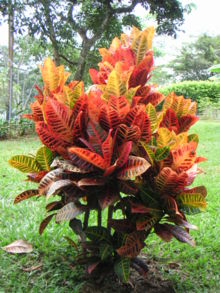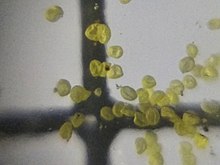Codiaeum variegatum
| Codiaeum variegatum | |
|---|---|

| |
| Scientific classification | |
| Kingdom: | Plantae |
| Clade: | Tracheophytes |
| Clade: | Angiosperms |
| Clade: | Eudicots |
| Clade: | Rosids |
| Order: | Malpighiales |
| Family: | Euphorbiaceae |
| Genus: | Codiaeum |
| Species: | C. variegatum
|
| Binomial name | |
| Codiaeum variegatum | |
| Synonyms | |
|
Many including
| |
Codiaeum variegatum (fire croton, garden croton, or variegated croton, or simply 'croton'; syn. Croton variegatum L.) is a species of Codiaeum, a genus of flowering plants, in the Euphorbiaceae (the spurge family). Initially described by Carl Linnaeus in 1753, it is native Australasia and Oceania, from Malaysia and Indonesia in the north through northeastern Australia, as well as many Southeast Asian and South Pacific islands, growing in open forests and scrub.[2][3][4]
The Codiaeums' commonly-used name of "croton" should not be confused with Croton, a separate genus—also within the spurge family—which contains more than 700 species of cosmopolitan herbs, shrubs and trees.
Description[edit]
Codiaeum variegatum is an evergreen and monoecious tropical shrub growing to 3 m (9.8 ft) tall, with thick, somewhat "leathery" and shiny, alternately-arranged leaves. The foliage may measure anywhere from 5–30 cm (2.0–11.8 in) long by 0.5–8 cm (0.20–3.15 in) broad. The shape of mature leaves may appear diamond- or teardrop-shaped—even violin-like—or ruler-lanceolate, lanceolate, oblong, elliptical, ovate-inverted, ovate-spatulate. The species is known for its vividly coloration (especially in higher sunlight), displaying almost "tie-dye"-like patterns of green, yellow and purple, in varying hues and intensity, depending on variety. The petiole has a length of 0.2 to 2.5 cm. Similarly to other euphorbs, the inflorescences are long racemes, 8–30 cm (3.1–11.8 in) long, with male and female flowers separated. Male flowers are white, with five small petals and 20–30 stamens. The pollens are oval in shape and approximately 52x32 microns in size. The female flowers are yellowish and lacking petals. The blooming period is usually in early autumn, depending on location. The inedible and toxic fruit (for most mammals) is a capsule measuring roughly 9 mm (0.35 in) in diameter, containing three seeds of 6 mm (0.24 in) diameter.
When broken or cut, every part of C. variegatum will "bleed" and drip a milky, caustic sap, eventually drying into a latex-like consistency, as is typical of the Euphorbiaceae.[2][3][5] Care must be taken to avoid touching this latex (i.e., only gardening while wearing thick, protective gloves, and eye or sunglasses).

Cultivation[edit]

In tropical climates, crotons make attractive hedges and potted patio specimens, valued for their striking foliage. They only survive outdoors where temperatures do not normally drop below 10 to 13 °C (50 to 55 °F) in winter; colder temperatures can cause leaf loss.[3] In colder climates, the plants are grown in greenhouses or as house plants. The cultivated garden crotons are usually smaller than the wild plant, rarely over 1.8 m (5.9 ft) tall, and come in a wide diversity of leaf shapes and colours. They are sometimes grouped under the name Codiaeum variegatum var. pictum (Lodd.) Müll. Arg.,[3] though this is not botanically distinct from the species and usually treated as a synonym of it.[2]
Cultivars[edit]
The several hundred cultivars are selected and bred for their foliage. Depending on the cultivar, the leaves may be ovate to linear, entire to deeply lobed or crinkled, and variegated with green, white, purple, orange, yellow, red, or pink. The colour patterns may follow the veins or the margins, or be in blotches on the leaf. Popular cultivars include 'Spirale', which has spirally twisted red and green leaves; 'Andreanum', which has broadly oval yellow leaves with gold veins and margins; 'Majesticum', which has pendulous branches, with linear leaves up to 25 cm (9.8 in) long with midrib veins yellow maturing to red; and 'Aureo-maculatum', which has leaves spotted with yellow.[3]
Toxicity[edit]
As with the majority of the spurges, when broken or cut, every part of C. variegatum will "bleed" and drip a milky, caustic sap, eventually drying into a latex-like consistency.[6][7][8] Care must be taken to avoid touching this latex, such as only handling the plant while wearing sufficiently protective gloves, as well as eye goggles or sunglasses. Generally, small, inadvertent drops of the sap on one's hands or skin will cause no ill effect in the majority of the population, provided it is promptly washed off using soapy, warm water—this may even followed with the use of a hand sanitizer or even a mildly diluted isopropyl alcohol. However, direct contact between the sap of Euphorbiaceae and the eyes, ears, nose, mouth, genitals, or any open wound, is strongly discouraged and may result in untold side effects. Complications stemming from sap contact may range from mild to extreme burning pain, itchiness, rash or temporary dulling of the senses; depending on the region of the body affected, this sensory reaction may include temporary or long-term complications with sight, hearing, taste, feeling or smell, among other issues. In certain sensitive-skinned individuals, contact with small amounts of the sap can cause contact dermatitis.[9] The entire plant, including its bark, roots, inflorescences and foliage, is poisonous.[10] The primary alkaloid present is the chemical compound 5-desoxyingenol.[10] The plant contains an oil which is violently purgative and a suspected carcinogen.[11] Consumption of the seeds can be fatal to children and even adults.[11]
Gallery[edit]
-
C. variegatum in Miyako-jima, Okinawa Prefecture, Japan
-
C. variegatum in Miyako-jima, Okinawa Prefecture
-
Completely yellow leaves on a specimen in Kolkata, India
-
Croton 'Petra' in a botanical garden
-
Narrow-leaved variety
-
A green-yellow variegated variety
-
Female flowers
-
Young fruits
References[edit]
- ^ G. Nicholson Ill. Dict. Gard. 1: 352 1885
- ^ a b c Flora of China: Codiaeum variegatum
- ^ a b c d e Huxley, A., ed. (1992). New RHS Dictionary of Gardening 1: 665. Macmillan.
- ^ "Codiaeum variegatum var. Moluccanum | Atlas of Living Australia". Archived from the original on 2015-10-02. Retrieved 2015-06-15.
- ^ Bingtao Li & Michael G. Gilbert: Codiaeum in the Flora of China , Volume 11, 2008, p. 268
- ^ Flora of China: Codiaeum variegatum
- ^ Huxley, A., ed. (1992). New RHS Dictionary of Gardening 1: 665. Macmillan.
- ^ Bingtao Li & Michael G. Gilbert: Codiaeum in the Flora of China , Volume 11, 2008, p. 268
- ^ Occupational contact dermatitis due to croton (Codiaeum variegatum (L.) A. Juss var. pictum (Lodd.) Muell. Arg.). Sensitization by plants of the Euphorbiaceae. Contact Dermatitis 1977 Dec. 3(6): 289-92. abstract.
- ^ a b National Tropical Botanical Garden Codiaeum variegatum (Euphorbiaceae) Archived 2011-07-19 at the Wayback Machine
- ^ a b "Croton (Codiaeum Variegatum)". Nova Scotia Museum. Archived from the original on 2017-11-07.








